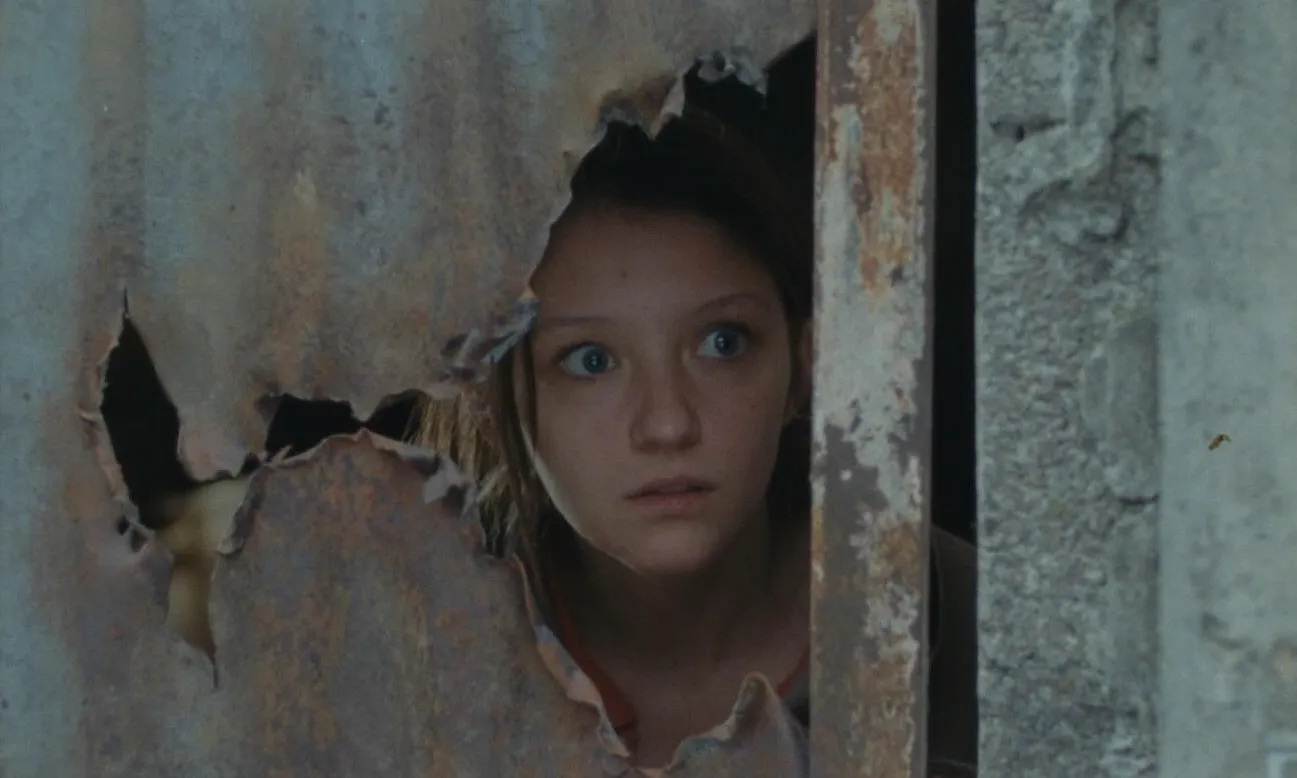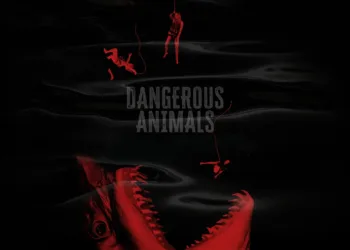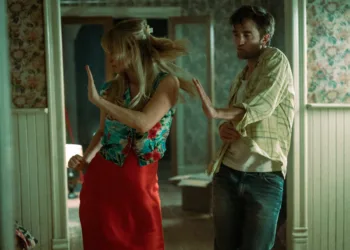Set against a rain-soaked French farm tended by a Polish migrant family, Her Will Be Done opens in a world ruled by routine: dawn chores in muddy stalls, evening prayers beneath creaking rafters. Nawojka, burdened by expectations to uphold her late mother’s fearful legacy, tends livestock with dutiful hands even as she dreams of studying veterinary medicine far beyond these fields.
Into this controlled rhythm strides Sandra, a leather-clad outsider whose return ignites whispered rumors and unsettled yearnings. As a strange malaise creeps through the herd—white, membrane-like patches marking fallen cattle—the film tightens its grip, weaving superstition and science into a single threat.
The cinematography bathes each frame in a grainy palette of greens and blood-toned reds, underscoring the tension between ancestral ritual and modern escape. In these opening moments, the story teases a collision of faith and desire, isolation and solidarity, hinting that salvation may lie in confronting both inherited fears and forbidden longings.
Shifting Rituals and Rising Tensions
Kowalski grounds the story in the farm’s daily grind: fields sodden by rain, rusted tools strewn outside sheds, and a cramped kitchen where Nawojka moves between stove and stable. These spaces feel lived-in, charged by the clash of Polish customs—prayer beads, old-world superstitions—and a French village that regards strangers with suspicion. Early scenes cast Nawojka as both caretaker and captive, her ambition to study veterinary science met with a father’s admonitions and brothers’ crude jokes.
Hints of possession arrive in quiet surges: a sleep-walking trance, a sudden tilt of the head, an unsettling stare that recalls the slow burn of plots like Robert Eggers’s The Witch. Sandra’s return cracks this veneer; her leather jacket and cigarette mark her as an outsider, yet her fearless gait stirs something in Nawojka’s stifled world.
When livestock begin to die—pale, gelatinous patches on hides, sudden collapses in the mud—the community turns to prayer rituals and protective medallions. A wedding-night celebration crescendos into a feverish vortex of alcohol, ominous red lighting, and frantic church chants. It’s a sequence that twists joy into terror with the same precision the Coen brothers bring to their genre inflections.
At its heart, the film examines the price of claiming one’s self against patriarchal demands, the uneasy border between faith and fear, and the power the community grants to its own legends. Pacing unfolds like a slow-pour draft of absinthe: contemplative moments steeped in silence, ruptured by bursts of raw, visceral imagery. Flashbacks glimmer briefly, offering shards of past horrors without spelling out every detail, inviting viewers to piece together Nawojka’s destiny as they would assemble a folk tale.
Embodying Ritual and Rebellion
Maria Wrobel brings Nawojka’s journey to life with an intensity that anchors every scene in palpable unease. She begins as a silent presence, her bowed shoulders and soft-spoken prayers evoking classic “innocent outcast” roles in folk horror—but Wrobel quickly fractures that mold. In moments of possession, her body convulses with visceral abandon, recalling the physical rigor of Ellen Burstyn in The Exorcist.
Then, in sudden stillness, her blank stare carries more weight than any scream, mapping Nawojka’s shift from dutiful daughter to a figure claiming her own agency. Whispered invocations rise into anguished cries, her vocal range underscoring a character caught between duty and desire.
Opposite her, Roxane Mesquida’s Sandra arrives in leather and defiance. Mesquida channels a Joan Jett–style swagger, yet cracks appear when she mentions past traumas. These slivers of vulnerability give the femme fatale more depth than a simple rebel archetype. Scenes between the two women ripple with undercurrents of attraction and mistrust—moments that call to mind the charged dynamics of Portrait of a Lady on Fire, though here the tension veers toward the uncanny.
Wojciech Skibinski’s Henryk embodies patriarchal care as much as he enforces it: gentle in tone yet rigid in ritual. His reliance on prayer and medallions speaks to a man searching for control amid forces he barely understands. The brothers, by contrast, swagger through scenes as embodiments of small-town aggression—mockery in one breath, predatory menace in the next.
Franck, the pragmatic veterinarian, offers a measured counterpoint to superstition, his clinical detachment highlighting the village’s collective fear. At the wedding, background villagers shift from celebratory dancers to hunters driven by panic, their transformation a testament to the ensemble’s power in amplifying communal dread. Together, these performances create a tapestry of conflict—each actor’s choices weaving into a broader meditation on belief, autonomy and the price of transgression.
Crafting Atmosphere Through Image and Sound
From the first frame, Simon Beaufils’s lens evokes a 1970s folk-horror aesthetic: grainy textures, muddy greens of the pastures and dusky browns of weathered barns punctuated by sudden flashes of crimson. Interiors feel tight and oppressive—the walls close in on Nawojka—while wide shots of drenched fields suggest both freedom and foreboding. Practical effects heighten the tactile horror: gelatinous, membrane-like growths on cattle hides, and brief distortions in Nawojka’s face during trance states that recall the organic surrealism of David Lynch’s early shorts.
The sound design marries the rustic and the uncanny. A lone guitar riff mingles with a simple flute melody at dawn, then gives way to swelling, atonal strings as the herd falls ill. Ambient farm noises—creaking beams, distant cow calls, whispered prayers—thread through the score, and moments of abrupt silence cut deeper than any scream, underscoring how isolation can amplify dread.
Editing choices reinforce this rhythm of unease. Long, steady takes allow tension to build in unbroken silence, while rapid intercuts during episodes of possession jolt us into Nawojka’s fractured perspective. Occasional flashbacks emerge without warning, dropping us into past torments that ripple into the present, much as memories surface in dreams.
Symbols weave through these stylistic choices. The livestock epidemic becomes a metaphor for traditions poisoned by fear of female autonomy. Henryk’s Saint Benedict medallion alternately shelters and shackles Nawojka. At Tomek’s wedding, an otherworldly red glow bathes the scene, turning celebration into a bloody ritual. Later, the descent into the forest marks a crossing of thresholds—in geography and psyche—underscoring how the film reimagines witchcraft lore as a journey of self-reclamation.
By fusing folk-horror tropes with psychological thriller pacing, the film situates itself between independent experimentation and genre convention, using every frame and sound cue to mirror its characters’ inner struggles. Her Will Be Done premiered in the Directors’ Fortnight section at the 2025 Cannes Film Festival.
Full Credits
Director: Julia Kowalski
Writer: Julia Kowalski
Producers: Estelle Robin-You, Flavien Giorda, Yann Gonzalez, Magdalena Zimecka, Marta Krzeptowska
Cast: Maria Wróbel, Roxane Mesquida, Wojciech Skibiński, Kuba Dyniewicz, Przemysław Przestrzelski, Raphaël Thiéry, Jean-Baptiste Durand, Éva Lallier, Laurence Côte
Director of Photography (Cinematographer): Simon Beaufils
Editor: Isabelle Manquillet
Composer: Daniel Kowalski
The Review
Her Will Be Done
Her Will Be Done stakes its claim as a haunting folk-horror that interrogates faith, gendered control and forbidden desire. Anchored by Maria Wrobel’s visceral performance and Simon Beaufils’s muddy, 1970s-tinged cinematography, the film balances steady dread with jolts of visceral shock, framing a stark portrait of autonomy set against oppressive traditions.
PROS
- Maria Wrobel’s performance delivers raw physicality and emotional depth.
- Simon Beaufils’s cinematography wraps the farm in unsettling, 1970s-tinged textures.
- Sound design mixes rustic ambiance with sudden silences to heighten tension.
- The symbolism of livestock plague and ritual meditations enriches thematic layers.
- Blend of folk-horror and psychological thriller feels fresh within its niche.
CONS
- Pacing can lag in quieter stretches, risking audience disengagement.
- Key backstory elements remain vague, leaving some motivations unclear.
- Supporting characters receive limited development beyond archetypal roles.
- Flashbacks interrupt momentum without fully clarifying past events.
- Final act lacks the impact of earlier set-pieces, softening the climax.

















































